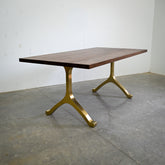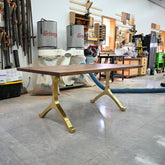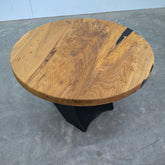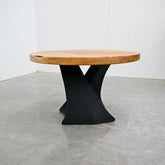How to Choose the Right Custom Table for Your Home
When it comes to furnishing your home, few pieces of furniture can transform a space like a custom table. Whether you're looking for a new dining table, coffee table, or desk, a table can set the tone for a room’s entire aesthetic. I’ve worked with many clients to create tables that complement their home’s style while meeting their practical needs. In this post, I’ll walk you through the process of choosing the perfect custom table for your home, taking into consideration your home’s style, room size, and functional requirements.
1. Identify Your Home Style
The first step in selecting the right table for your home is understanding the overall design aesthetic of the space. The style of your home plays a pivotal role in determining the materials, finish, and shape of the table. Here’s a breakdown of how to match your table with different home styles:
Modern Style
Modern homes are all about clean lines, minimalism, and functional design. When designing a custom table for a modern home, think about sleek, streamlined shapes and materials. Opt for tables with straight lines and geometric shapes, such as rectangular or round tables.
- Wood Finish: Lighter woods, like ash or maple, work well for modern interiors, though some people also enjoy darker wood finishes like walnut for a bit more contrast.
- Table Shape: Round and oval tables are popular in modern designs as they encourage conversation and provide a softer look. Square and rectangular tables with sharp edges also fit well.
- Additional Features: Minimal adornments, hidden storage, or extending features for versatility can complement modern functionality.
Traditional Style
Traditional homes feature classic designs with rich details, elegant finishes, and timeless appeal. If you have a traditional-style home, you'll want a table that feels refined and sturdy, with ornate or classic details.
- Wood Finish: Darker woods like cherry or walnut are a hallmark of traditional furniture. These woods exude warmth and sophistication.
- Table Shape: Oval or rectangular tables work best for traditional interiors, with options for carved details or turned legs for added elegance.
- Additional Features: Traditional designs often include intricate detailing, such as inlays or distressed finishes, which can add a sense of history to your space.
Industrial Style
If your home has an industrial style, you’ll want to embrace a blend of raw, unfinished materials and a more utilitarian design. Think of metal and a rugged aesthetic that pairs perfectly with exposed brick walls and open shelving.
- Wood Finish: A weathered, reclaimed look is ideal for industrial tables. Woods like oak, pine, or reclaimed timber are perfect for achieving that worn-in, rustic feel.
- Table Shape: Rectangular tables with sturdy, thick wood tops paired with metal legs work beautifully in an industrial space. The juxtaposition of wood and metal can create a striking design.
- Additional Features: Industrial-style tables often incorporate steel or iron legs, rivet detailing, and other raw metal accents to emphasize the functional beauty of the piece.
Farmhouse Style
Farmhouse designs are all about comfort, simplicity, and rustic charm. A farmhouse table has a sturdy, lived-in feel and is usually the heart of the home, whether in the kitchen, dining room, or even a home office.
- Wood Finish: Lighter woods such as oak are staples in farmhouse designs, often with a weathered or distressed finish.
- Table Shape: Rectangular or oval tables with simple lines and sturdy construction work best. The table should feel inviting, not too fussy or ornate.
- Additional Features: Farmhouse tables often feature large, thick legs (like turned or tapered), and they are built to last and withstand heavy use.
Mid-Century Modern
Mid-century modern homes boast a sleek, functional, and often retro-inspired design. If your home features this style, you’ll want a table that showcases clean lines, simple elegance, and functionality.
- Wood Finish: Walnut, and oak are common in mid-century modern design. These woods have natural warmth and simplicity.
- Table Shape: Round or oval tables are popular in mid-century modern spaces, often with slightly angled legs that give the table a vintage yet timeless look.
- Additional Features: Mid-century modern tables often have low-profile designs and minimal embellishments. Look for functional, versatile designs that can fit into various types of spaces.
2. Consider Room Size and Layout
The next critical factor in choosing a custom table is your room size and layout. You don’t want a table that overwhelms the space, nor do you want something that feels too small for the room. The right table should complement the size and flow of the space.
Small Spaces
For smaller rooms, the goal is to choose a table that maximizes functionality without crowding the space. In dining rooms or kitchens, consider a table that’s compact and functional. Round tables are a great choice for tight spaces because they don’t have sharp corners and can help facilitate better flow within the room. A smaller rectangular table or a bench-style table can also be an excellent choice if you need something space-efficient.
- Tip: Multi-functional tables that can double as a work surface or feature extendable leaves are great for smaller spaces.
Large Rooms
In larger rooms, you have more flexibility with the size of the table you choose, but that doesn’t mean bigger is always better. A large, custom table can be a beautiful focal point in a spacious room, but you’ll want to ensure it doesn’t look out of place. If you have a large dining room, consider a table that comfortably fits your family’s needs, with extra space for guests. A statement piece like a long wooden table with a bold design or unique finish can help define the room and add character.
- Tip: Opt for oversized tables with an extension feature if you regularly host large gatherings, or choose a table with a central base for a dramatic look.
Open Concept Spaces
For open concept homes, where the dining, living, and kitchen areas flow together, the table needs to function as part of the larger design. The table should be proportionate to the space but also complement adjacent areas.
- Tip: Think about the height of the table, especially in open concept spaces, where an adjustable or high bar-style table might suit your layout and make the room feel more open and airy.
3. Think About Functionality and Practical Needs
Beyond style and size, it’s essential to think about the functional needs of the table. How will you use it? Will it serve as a family gathering space, a place to work, or just a decorative statement piece? Here are a few functional aspects to consider when selecting a custom table:
Dining Tables
If you’re looking for a dining table, think about how many people typically gather around it. If you frequently host guests or have a large family, an expandable table can be a great choice. When designing your table, also consider the height—standard dining tables are around 28–30 inches, but counter-height or bar-height tables are popular in kitchens and more casual dining areas.
- Tip: Consider your chairs when designing your dining table. The height of the legs and the space between the table and seat should allow for comfortable dining.
Coffee Tables
When designing a custom coffee table, consider the scale of the room and the other furniture in the space. The coffee table should be proportional to your sofa, providing easy access to drinks or books without crowding the room. Square, round, and rectangular tables are all good options.
- Tip: If your living room is used frequently for gatherings, consider a coffee table with storage to help reduce clutter.
Desks and Work Tables
A custom desk for a home office should combine functionality with a style that matches the rest of the home. Consider your storage needs—do you need drawers, open shelving, or a minimalist design? Think about the surface space required for your work, as well as the ergonomics of the chair and desk height.
- Tip: A well-designed desk can blend seamlessly into your living space, making it an elegant addition to your home even when not in use.
4. Final Thoughts
Choosing the right custom table for your home is about finding a balance between style, size, and function. Whether you’re opting for a modern, traditional, industrial, or farmhouse table, it's important to think about how the table will be used and how it complements the overall aesthetic of your home. By considering these factors, you can select a custom table that enhances your space and meets your practical needs.
At Hoffer Woodworking, we specialize in creating high-quality, one-of-a-kind tables tailored to your specific tastes and requirements. If you’re unsure about what design or material will work best in your space, feel free to reach out. I’m happy to help guide you through the process of choosing a table that’s perfect for your home, and I’m always excited to create pieces that will become a lasting part of your home.





